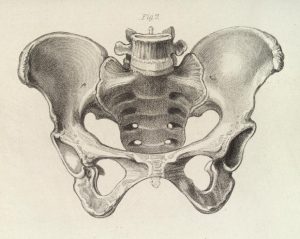Pelvis Lesson
 ‘I have always wondered, what I should do with my pelvis.’
‘I have always wondered, what I should do with my pelvis.’
‘I stood there for hours with my pelvis pushed forward.’
These are just two comments, made by students, who are aware of their confusion around their pelvis. Most of us are much less cognizant of our underlying patterns around this central structure in our skeleton.
The pelvis is a big bony structure right in the center of our upright body. It forms the base of the spine and is the counterpoint to the head. Head and pelvis are two heavy structures at opposite ends of the spine. Misuse at either end, can influence the healthy curvature of the spine and thus cause postural problems and/or pain in back or neck. The weight of the pelvis amounts to 15% of our entire body weight, while the weight of your head is more succinctly measured at 10-12 pounds. The pelvis is a solid bony structure to distribute the weight of head and torso through both legs to the feet into the ground.
 Working on your body’s center will help to lengthen your stature, release your back and leg muscles, flatten your tummy, re-set the shoulders, release the neck and re-balance your head, and in the end will help you to have a clearer sense of yourself and perspective out into the world.
Working on your body’s center will help to lengthen your stature, release your back and leg muscles, flatten your tummy, re-set the shoulders, release the neck and re-balance your head, and in the end will help you to have a clearer sense of yourself and perspective out into the world.
Let’s explore:
1. Preferably but not necessarily while standing, take both hands to the sides of your pelvis bones, feeling the contours of this structure; then take your hands to the front and back of your pelvis- the front hand cupping the lower abdomen, the back hand on the sarco-iliac area.
2. Maybe hold and palpate a little longer while re-reading the paragraph above: The pelvis is a big bony structure right in the center of our upright body. It forms the base of the spine and is the counterpoint to the head. Head and pelvis are two heavy structures at opposite ends of the spine. Misuse at either end, can influence the healthy curvature of the spine and thus cause postural problems and/or pain in back or neck. The weight of the pelvis amounts to 15% of our entire body weight, while the weight of your head is more succinctly measured at 10-12 pounds. The pelvis is a solid bony structure to distribute the weight of head and torso through both legs to the feet into the ground.
3. Now, while keeping your interested hands on the pelvis, walk around the room for a while; then come to stand. Repeat this a few times, walking and halting. What do you notice when you stop walking?
4. The moment of stopping often reveals, what we do unconsciously with our pelvis in a quiet pose. Visible or invisible, tensions reveal themselves in stillness. There is a long list of options. Exploring this takes time. Do you tend to
• pull your stomach in
• contract your pelvic floor muscles
• narrow your bony pelvic structures
• sway the pelvis back so that your lower spine is in a pronounced forward curve
• tuck the pelvis forward underneath you so that your lower spine flattens
• lean your pelvis against a counter at home or in stores
• stand on your preferred leg
All of these possibilities are more or less positions of holding and fixing, instead of an availability to move.
5. We cannot possibly know our unconscious habitual patterns while reading a blog. If you are willing, take the questions as a guideline for further exploration, while talking on the phone, standing in line, making dinner, in your car, at an event…
6. Lastly, a deceivingly simple assignment: After you come to a quiet place, sitting or standing, do nothing!
Doing nothing is super difficult, but try the following directions:
• I am leaving my pelvis alone.
• I let this big bony structure hang from the spine and release my head away from the pelvis, as well as the pelvis away from the head. No muscles needed, no shape nor shame.
• Do a simple daily activity, like taking a shower or making coffee, standing well supported – and give yourself the direction ‘I am leaving my pelvis alone’. Renew this self-instruction repeatedly all the time for the whole length of the activity, and notice your sneaky habitual muscular actions.
• Explore if it is easier to un-do the activity of pelvis muscles when you are standing, lying down or walking?
• Don’t be perfect, do find rest, explore your pelvis habit, while reading in bed, resting on a couch, sitting in a chair, standing in line, waiting for a phone connection…
In German the sacrum is called “cross bone”, the crux! The crux of our entire structure, the keystone of our pelvis architecture, a basin or bowl, our center. It’s heavy – in more than one sense!


Can this release an overly-tight (hypertonic) pelvic floor?
Thank you so much for replying to this old post of mine! Positional pelvic release and muscular pelvic floor release are closely connected. Ease and release of overactive muscles would be the area to address. Wherever you are, please seek an Alexander Technique teacher to join your journey; they might also guide you to other practitioners to address your concerns.
Feel free to contact me by email, in case I could do anything online for you.
Best, Michaela